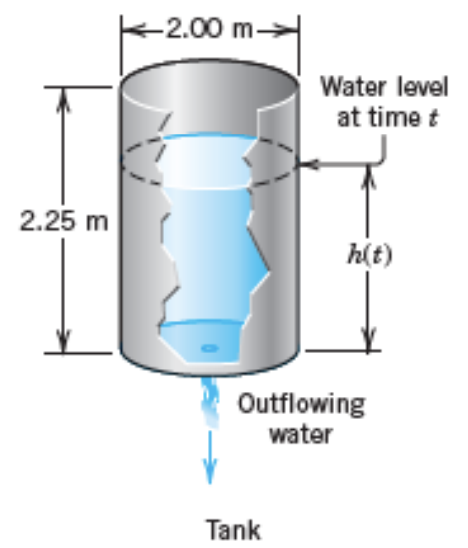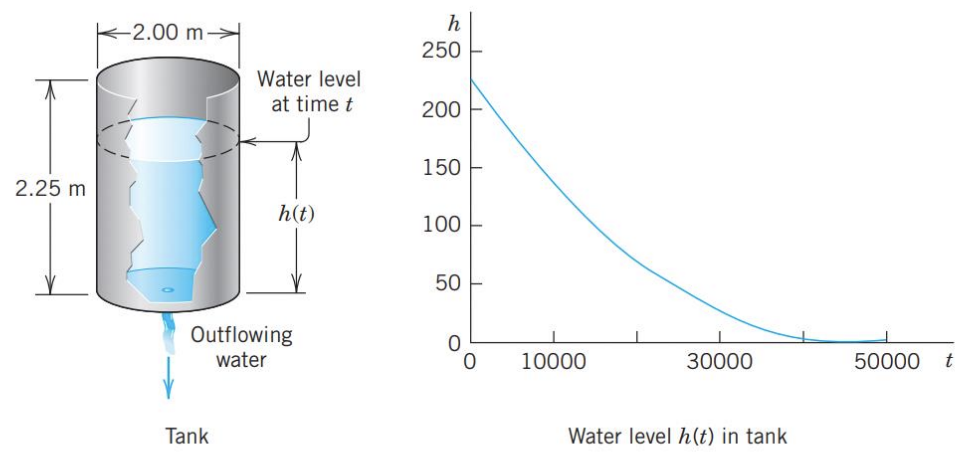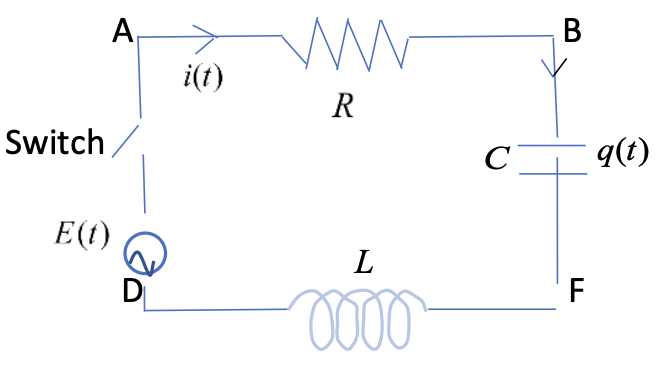Tutorial 5: Engineering Applications of Differential Equations
Tutorial Question
-
a. Given the population of rabbit in human habitat (rabbit farm) grows at a rate proportional to the number of rabbit at time (year). It is observed that 200 and 800 rabbits are presented at 3rd year and 6th year respectively. What was the initial number of the rabbit, ? How long does it take the population to double to .
SolutionLet amount of rabit . Hence, where is a constant.
[Complicated and cannot be solved]
Use separable method,
Given , we get
and
Eqn (2) divided (1)
Hence,
At , number of rabbit is integer hence it is predicted that the initial number of rabbit is .
b. A person has bought 1000 rabbits from the farm and releases them to the jungle that is full of predator (i.e. snakes at the time he/she releases the rabbit). Given the governing equation of the rabbit population is changed to . How long does it take the rabbit population to decrease to half?
Hint: The doubling time decrease/increase to its initial amount/quantity is related to half-life concept. Students are encouraged to study its application in engineering. For example, to compare the charging time performance of various capacitors using half-life indicator in electrical field.
SolutionBy using partial fraction decomposition:
Hence,
Note: This is implicit solution for the system because the solution cannot be expressed in the explicit form, i.e. .
For the rabbit population to decrease to half,
It takes years
-
A brine mixing problem is illustrated in the following figure where a tank contains a liquid of volume with concentration initially and two valves (A & B) are opened simultaneously. The rate of change for the amount of salt in the tank over time is given: . Let amount of salt; concentration of salt over time ; ; . What is the change of the amount of salt and also the change of its concentration over time.
 Solution
SolutionStep 1: Linear Form
Step 2: Integrating Factor
Step 3: Multiply
Step 4: Exact
Step 5: Integrate
[Change of the amount of salt over time]
[ Change of the concentration of salt over time]
-
The figure below shows the outflow of water from a cylindrical tank with a hole at the bottom. Determine the height of the water in the tank at any time if the tank has a diameter of 2m, the hole has diameter 1cm, and the initial height of the water when the hole is opened is 2.25m. When will the tank be empty?
 Solution
SolutionStep 1: Setting up the model
To get an equation, we relate the decrease in water level to the outflow. The volume of the outflow during a short time is
must equal the change of the volume of the water in the tank. Now
where is the decrease of the height of the water. The minus sign appears because the volume of the water in the tank decreases. Equating and gives
We now express according to Torricelli's law and then let (the length of the time interval considered) approach 0 - this is a standard way of obtaining an ODE as a model. That is, we have
and by letting we obtain the ODE
where . This is our model, a first-order ODE.
Step 2: General solution
Our ODE is separable. is constant. Separation and integration gives
Dividing by 2 and squaring gives . Inserting yields the general solution
Step 3: Particular solution
The initial height (the initial condition) is . Substitution of and gives from the general solution and thus the particular solution
Step 4: Tank empty
Here you see distinctly the importance of the choice of units — we have been working with the cgs system, in which time is measured in seconds! We used .
Step 5: Checking
Check the result.

-
Given the governing equation for RLC electrical circuit: . An inductor of henrys and a resistor of ohms are connected in series with an emf of volts. Note that in this case the capacitor has been removed. At , the switch is closed, thus no charge and current flow at that moment. Find the charge and current at any time if

a. volts
SolutionIt is linear differential equation that can is separable
Apply initial condition ,
Apply initial condition ,
You can get the same answer by using linear differential equation with integrating factor:
where
Hence
[Same answer as previous]
Note: There are at least one method to solve the differential equation. Choose the favourable one in term of efficiency. In term of accuracy, all provide the correct answer.
b. a. volts
SolutionIt is linear differential equation that is separable
Difficult to be solved in this form, try other method.
where
Thus
Hence,
Hence,
-
Let the governing equation for a vibrating car structure: . , . Find the total solution for the 2nd order ODE equation if the forcing function is given as follows:
a. No excitation, and it is subjected to initial condition. Hence prove that the solutions are linearly independent to each other.
SolutionHomogeneous Part,
Characteristic equation:
Comment: A pair of complex conjugates roots ()
Complementary solution:
where
Initial Value Problem
Solving (1) and (2) simultaneously,
b. Repeat the same problem in 5(a) with various combinations of damping, i.e. .
SolutionHomogeneous Part,
Characteristic equation:
Comment: Repeated real root ()
Complementary solution:
Initial Value Problem
c. Repeat the same problem in 5(a) with various combinations of damping, i.e. .
SolutionHomogeneous Part,
Characteristic equation:
Comment: Real and distinct root ()
Complementary solution:
Initial Value Problem
Solving (1) and (2) simultaneously,
-
Continue the problem 5. Let the governing equation for a vibrating car structure: , . Find the total solution for the 2nd order ODE equation if the forcing function is given as follows:
a. Engine excitation
SolutionStep 1: Homogeneous Part Step 2: Nonhomogeneous Part
,Characteristic equation:
Comment: A pair of complex conjugates roots
()
Complementary solution:For exponential function, ,
Since ,
Assume ,
Differentiate it gives,
Then, we get
Comparing the coefficient,
Actual particular solution,The complete/general solution to is .
Initial Value Problem
b. Engine excitation
SolutionStep 1: Homogeneous Part Step 2: Nonhomogeneous Part
,Characteristic equation:
Comment: A pair of complex conjugates roots
()
Complementary solution:For exponential function, ,
Since ,
Assume ,
Differentiate it gives,
Then, we get
Comparing the coefficient,
Actual particular solution,The complete/general solution to is
Initial Value Problem
c. Engine excitation
SolutionStep 1: Homogeneous Part Step 2: Nonhomogeneous Part
,Characteristic equation:
Comment: A pair of complex conjugates roots
()
Complementary solution:For exponential function,
Since ,
Differentiate it gives,
Then, we get
Comparing the coefficient,
Actual particular solution,The complete/general solution to is
Initial Value Problem
d. Engine excitation
SolutionStep 1: Homogeneous Part Step 2: Nonhomogeneous Part Characteristic equation:
Comment: A pair of complex conjugates roots
()
Complementary solution:For exponential function, ,
Since ,
Assume ,
Differentiate it gives,
Then, we get
Comparing the coefficient,
Actual particular solution,
The complete/general solution to is
Initial Value Problem
e. Road excitation
SolutionStep 1: Homogeneous Part Step 2: Nonhomogeneous Part
Characteristic equation:
Comment: A pair of complex conjugates roots
()
Complementary solution:For polynomial function, ,
Since ,
Differentiate it gives,
Then, we get
Actual particular solution,The complete/general solution to is
Initial Value Problem
f. Road excitation
SolutionStep 1: Homogeneous Part Step 2: Nonhomogeneous Part
Characteristic equation:
Comment: A pair of complex conjugates roots
()
Complementary solution:For polynomial function, ,
Since ,
Differentiate it gives,
Then, we get
Comparing coefficients,
Actual particular solution,The complete/general solution to is
Initial Value Problem
g. Road excitation
SolutionStep 1: Homogeneous Part Step 2: Nonhomogeneous Part
Characteristic equation:
Comment: A pair of complex conjugates roots
()
Complementary solution:
Integration by part,
Integration by part,
where:The complete/general solution to is
Initial Value Problem